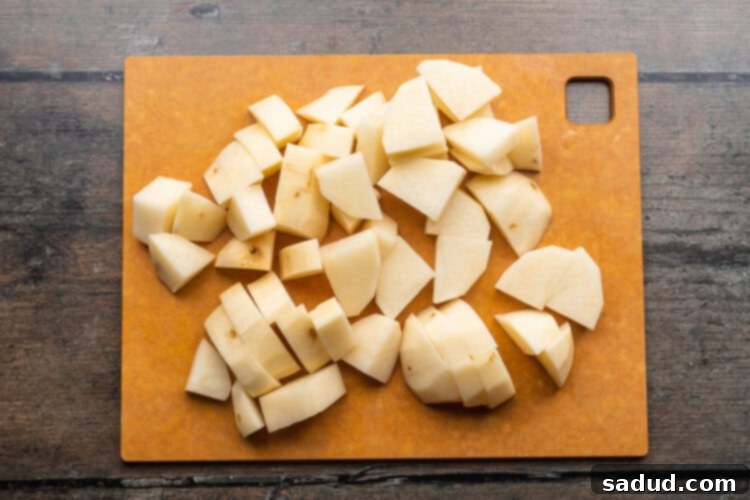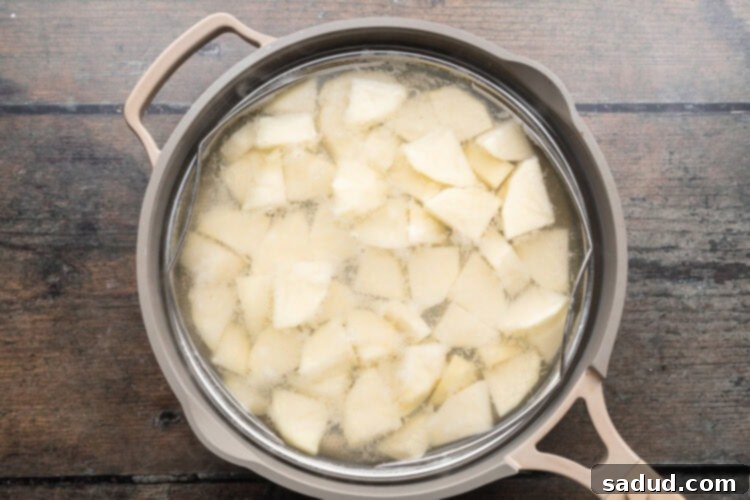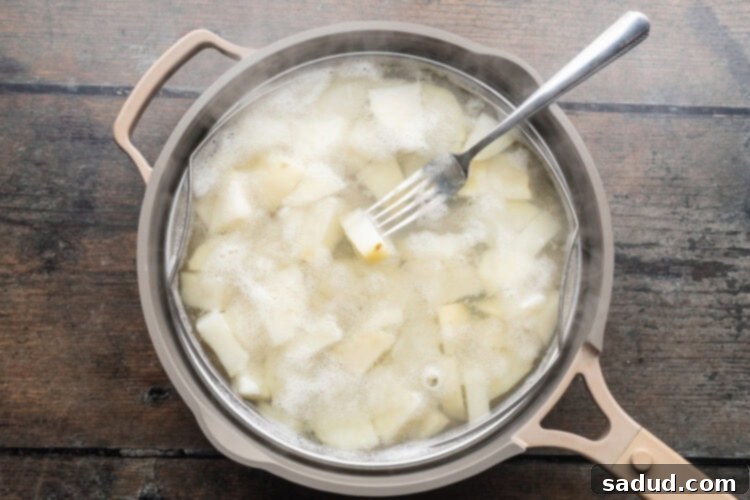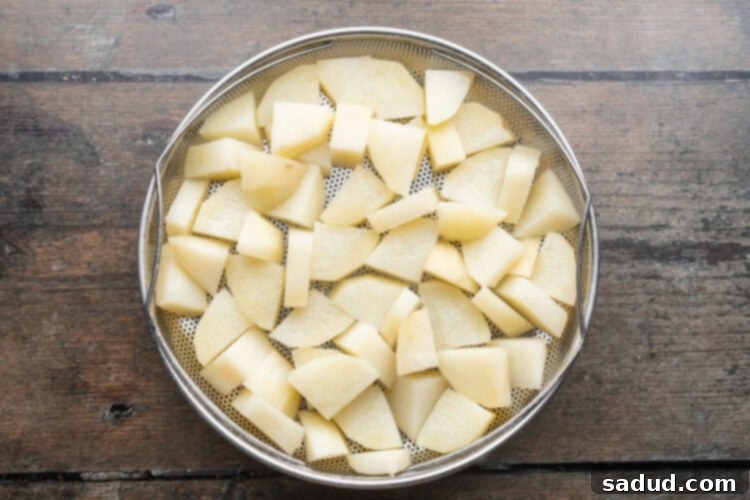Master the Art of Blanching Potatoes: Your Ultimate Guide for Perfect Texture & Faster Cooking
Unlock the secret to perfectly prepared potatoes with blanching – a simple yet powerful technique that transforms your cooking. Whether you’re aiming for crispy French fries, delightfully crunchy potato chips, or simply looking to streamline your weeknight dinner prep, learning how to blanch potatoes is a game-changer. This quick and easy method sets your potatoes up for success, ensuring optimal texture, flavor, and significantly reduced cooking times for your final dish. Moreover, it’s an absolute essential if you plan to freeze potatoes for future use, safeguarding their quality and preventing common pitfalls like mushiness and discoloration. Dive into this guide and discover how this fundamental skill can elevate all your potato-based creations, guaranteeing consistent, delicious results every single time.
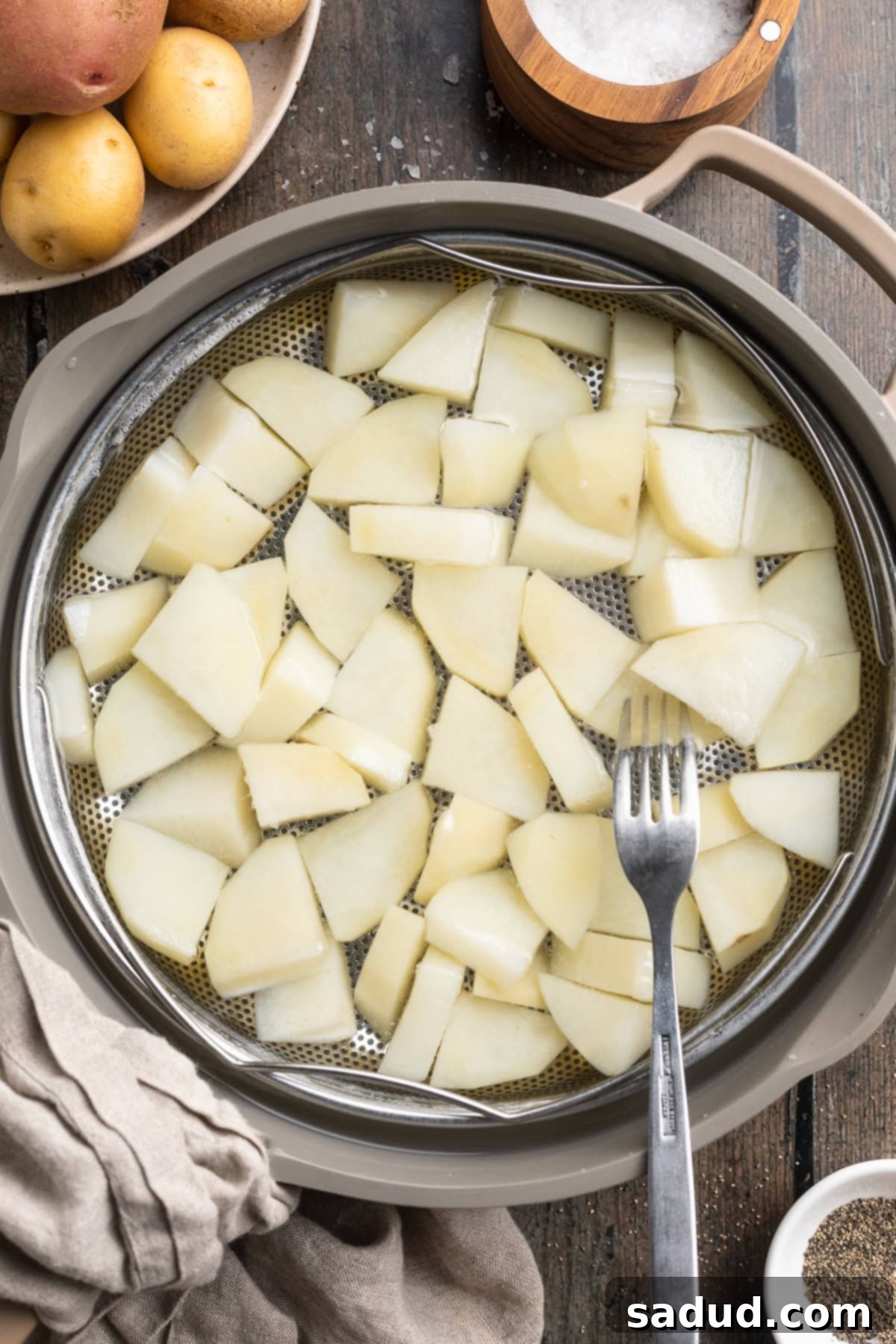
Why Blanching Potatoes is a Must-Know Kitchen Skill
Blanching potatoes might not be a daily ritual, but it’s an invaluable technique that every home cook should master. This process involves partially cooking your potatoes in simmering water, effectively “jump-starting” their cooking process without fully softening them. This initial step offers a multitude of benefits that impact both the cooking experience and the final outcome of your dishes.
- Accelerated Cooking Times: Blanched potatoes cook significantly faster than raw potatoes. This pre-cooking shaves precious minutes off your overall meal preparation, making it an ideal strategy for busy weeknights or when you need to prepare large quantities. Imagine whipping up roasted potatoes or mashed potatoes in a fraction of the usual time – that’s the power of blanching!
- Superior Texture and Crispiness: For dishes like French fries, potato chips, or even roasted potatoes, blanching is crucial for achieving that coveted crispy exterior and tender interior. It helps to remove excess surface starch, which can otherwise lead to a gummy texture, and creates a beautifully golden crust when subsequently fried or baked.
- Essential for Freezing Potatoes: If you’re planning to freeze potatoes, blanching is non-negotiable. Potatoes are rich in water, and without blanching, freezing and thawing can severely degrade their texture, turning them mushy and unappetizing. Blanching effectively inactivates enzymes responsible for cellular breakdown, preserving the potato’s structural integrity, flavor, and vibrant color during freezer storage. This means your frozen blanched potatoes will retain their quality, ready to be transformed into any dish you desire.
- Locks in Flavor and Nutrients: The rapid heat of blanching helps to set the potato’s natural flavors and can even help retain certain water-soluble vitamins that might otherwise be lost during longer cooking processes. It’s a gentle way to prepare potatoes that respects their inherent goodness.
- Unleash Culinary Versatility: Once blanched, potatoes become incredibly versatile. They’re perfect for quick fries, homemade chips, perfectly roasted wedges, creamy mashed potatoes, or even added to gratins and casseroles. This preliminary step makes subsequent cooking faster and more predictable, allowing you to experiment with various recipes with confidence.
Expert Tips for Perfectly Blanched Potatoes
Achieving perfectly blanched potatoes requires a few key considerations and techniques. Following these chef-approved tips will ensure your potatoes are ready for whatever culinary adventure awaits them, maintaining their ideal texture and flavor.
- Choose Your Potatoes Wisely: While most potato varieties can be blanched, some are better suited for specific applications. Starchy potatoes like Russets are excellent for fries and mashing due to their fluffy texture, while waxy varieties like Yukon Golds or Red Bliss hold their shape better for roasting or potato salads. For general blanching to freeze or use later, any common variety works well.
- The Art of Chopping: The size and shape of your potato pieces are entirely dependent on their intended use.
- For **French fries**, cut them into uniform sticks or wedges for even cooking.
- For homemade **potato chips**, thin, consistent discs are ideal.
- If you’re blanching potatoes for **roasting, mashing, or general use**, 1.5 to 2-inch cubes are highly versatile. This size ensures they cook efficiently without becoming too soft too quickly.
- Avoid excessively small pieces, as they cook much faster and are prone to overcooking during the blanching process. For naturally small potatoes like baby potatoes or fingerlings, blanching them whole or halved is usually best. Uniformity in size is key for even blanching.
- Simmer, Don’t Boil: This is perhaps the most critical distinction in blanching. When you *boil* potatoes for a recipe (like mashed potatoes), you cook them fully until fork-tender. For blanched potatoes, the goal is *partial* cooking. You should never bring the water to a rolling boil during the blanching stage. Instead, bring the water to a simmer, characterized by gentle bubbling, and maintain that temperature throughout. A gentle simmer cooks the potatoes evenly without breaking down their structure too much, preventing them from becoming mushy.
- Perfect Doneness – The Fork Test: How do you know when blanched potatoes are ready? Unlike fully boiled potatoes that a fork can easily pierce, blanched potatoes should offer *some resistance* when you try to stab them with a fork. The fork tines should just barely penetrate the potato. If the fork slides through effortlessly, you’ve overcooked them, crossing the line into boiled territory. This slight firmness is what makes them ideal for further cooking, as they’ll retain their shape and texture.
- The Indispensable Ice Bath: If you’re not planning to use your blanched potatoes immediately after cooking, an ice bath is absolutely essential. An ice bath is a bowl filled with ice and cold water. Transferring the hot potatoes directly into this bath immediately stops the cooking process. This “shocking” prevents residual heat from continuing to cook the potatoes, preserving their perfect texture and vibrant color. Let them chill for about 5 minutes, then drain thoroughly.
- Proper Drying is Key: After the ice bath (or if using immediately after draining), it’s crucial to dry your blanched potatoes thoroughly with paper towels. Excess moisture can prevent browning and crisping in subsequent cooking steps, especially if you’re frying or roasting them.
- Storage and Freezing Guidelines:
- Refrigeration: Properly blanched and dried potatoes can be stored in an airtight container in the refrigerator for up to 3 days.
- Freezing: For longer storage, blanching is a must. After the ice bath and thorough drying, spread the blanched potato pieces in a single layer on a baking sheet. Freeze them on the pan for at least 2-3 hours, or until solid. This prevents them from sticking together. Once frozen, transfer the individual pieces to a freezer-safe bag or container. This way, you can grab exactly the amount you need without thawing the entire batch. Blanched potatoes can be frozen for up to 3 months without significant loss of quality.

Other Essential Kitchen How-To Guides You Should Explore
- How to Cook Turkey Bacon in the Oven
- How to Steam Potatoes for Healthy Sides
- All About Lemon Zest + 4 Ways to Zest a Lemon for Maximum Flavor
- How to Boil Artichokes + 3 Healthy Dipping Sauces
- How To Cook Butternut Squash (3 Delicious Ways)
If you loved this essential cooking technique as much as we do, don’t forget to leave us a review below. ★ Follow Easy Healthy Recipes on Pinterest, Facebook, and Instagram, too!
For more delicious and healthy recipes, visit our sister sites, 40 Aprons and Easy Cheap Recipes.
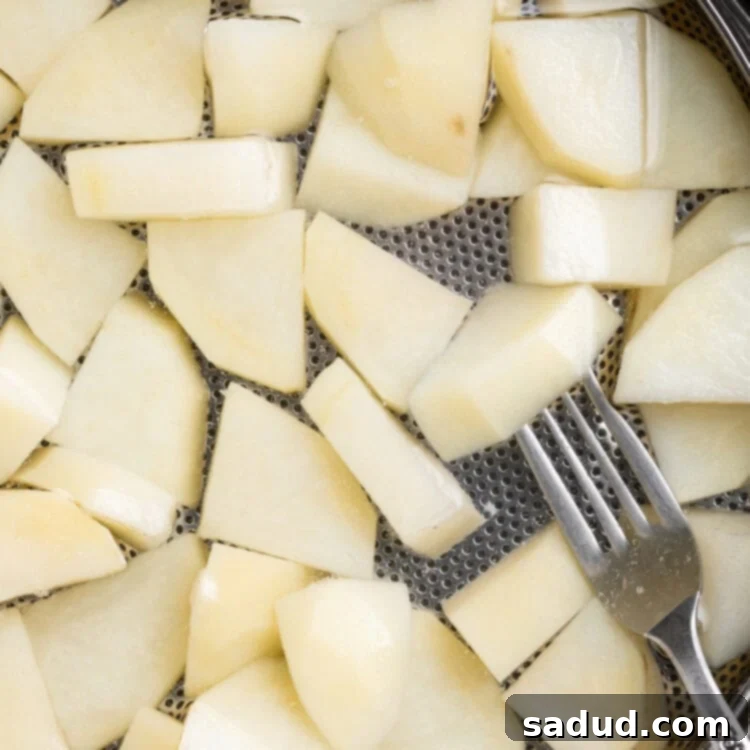
How to Blanch Potatoes: Simple Step-By-Step Guide
 Sam Guarnieri
Sam Guarnieri
Print
SaveSaved!
Ingredients
- 3 pounds whole potatoes any variety, such as Russet, Yukon Gold, or Red Bliss
- room-temperature water to cover potatoes
- 1 big pinch salt or more, to taste
- Ice for ice bath, if storing for later use
Equipment
-
Vegetable scrub brush or clean dish towel
-
Potato peeler optional, see Notes
-
Cutting board
-
Sharp knife
-
Large pot no lid needed
-
Fork
-
Colander
-
Large bowl for ice bath
-
Paper towels
Instructions
-
Start by thoroughly washing the potatoes under cold running water. Use a vegetable scrub brush or a clean dish towel to remove any dirt or debris from the skins.
-
Next, peel the potatoes completely using a potato peeler. While you can leave the skins on (see Notes), peeling helps speed up the blanching process and can result in a smoother texture for certain dishes. After peeling, chop the potatoes into your desired size and shape. For general use, 2-inch cubes are excellent. If making fries, cut into uniform sticks or wedges.

-
Place the chopped potatoes into a large, heavy-bottomed pot. Sprinkle a generous pinch of salt over the potatoes, then fill the pot with enough room-temperature water to cover the potatoes by approximately 1 inch.

-
Place the pot over high heat. As soon as the water begins to gently simmer (you’ll see small bubbles forming and rising, not a rolling boil), immediately reduce the heat to medium-low. Maintain this gentle simmer throughout the cooking process. It’s crucial not to allow the water to come to a full, vigorous boil.
-
Simmer the potatoes for about 8 minutes. At this point, carefully test the potatoes with a fork. Continue simmering, checking every minute or so, for up to 12 minutes total, until the tines of the fork can pierce the potatoes with some slight resistance. They should not be fully soft. Note: If the fork pushes through very easily, the potatoes are overcooked for blanching purposes.

-
Once the potatoes reach the desired doneness, immediately and carefully pour the entire contents of the pot (water and potatoes) into a colander to drain thoroughly. If you plan to use the potatoes right away, they are ready! If you are not using them immediately or plan to freeze them, quickly transfer the drained potatoes to a large bowl filled with ice and cold water (an ice bath). Let them cool in the ice bath for about 5 minutes to completely stop the cooking. Drain again, then thoroughly pat the potatoes dry with paper towels before transferring to an airtight container for refrigeration or preparing for freezing.

Notes
- Peeling Potatoes: You can opt to leave the skins on your potatoes, which can add a rustic touch and some nutritional fiber. However, be aware that leaving the skins on will likely make the blanching process take a little longer. If you choose this route, ensure the skins are meticulously cleaned before cooking.
- Draining Safely: If your pot of potatoes and water is too heavy to comfortably lift and pour into a colander, use a large slotted spoon or spider strainer to carefully transfer the blanched potato pieces from the hot water to the colander. Always prioritize safety in the kitchen.
- Salt for Flavor: Adding salt to the blanching water seasons the potatoes from the inside out, enhancing their flavor before they even hit the pan for final cooking.
Nutrition Information
Number of total servings shown is approximate. Actual number of servings will depend on your preferred portion sizes.
Nutritional values shown are general guidelines and reflect information for 1 serving using the ingredients listed, not including any optional ingredients. Actual macros may vary slightly depending on specific brands and types of ingredients used.
To determine the weight of one serving, prepare the recipe as instructed. Weigh the finished recipe, then divide the weight of the finished recipe (not including the weight of the container the food is in) by the desired number of servings. Result will be the weight of one serving.
Embracing the blanching technique is more than just another cooking step; it’s an investment in the quality and efficiency of your potato dishes. By taking a few extra minutes to pre-cook your potatoes, you’re ensuring superior texture, richer flavor, and the ultimate versatility for all your culinary adventures. Whether you’re a seasoned chef or a home cook looking to elevate your skills, mastering how to blanch potatoes will undoubtedly become one of your most valued kitchen secrets. So, gather your potatoes, follow these simple steps, and prepare to be amazed by the delicious difference blanching makes!
